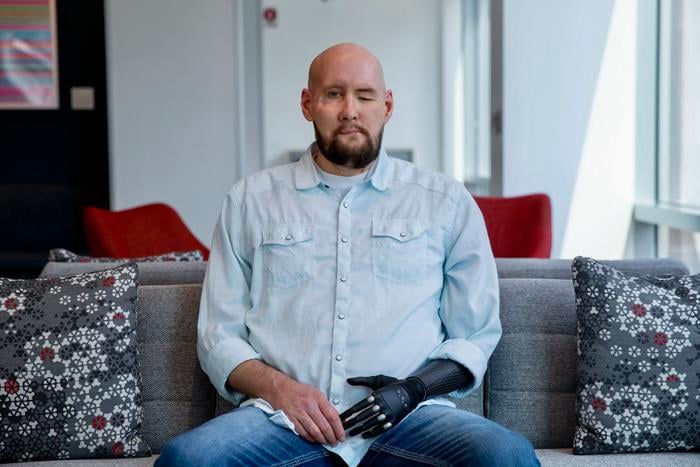Summary: A groundbreaking whole-eye and partial-face transplant performed on a 46-year-old veteran has shown remarkable results one year post-surgery, with the transplanted eye maintaining viability and demonstrating retinal responses to light.
Estimated reading time: 7 minutes
In a medical first, surgeons at NYU Langone Health have successfully performed a combined whole-eye and partial-face transplant on Aaron James, a 46-year-old military veteran who suffered a severe electrical injury. One year after the pioneering 21-hour surgery, James has made a remarkable recovery, regaining many aspects of normal life.
The groundbreaking procedure, detailed in a study published in the Journal of the American Medical Association (JAMA), offers new hope for patients with catastrophic facial injuries and vision loss. While the transplanted eye has not regained sight, it has maintained normal pressure and blood flow, defying expectations based on previous animal studies.
Why it matters: This unprecedented transplant pushes the boundaries of reconstructive surgery and transplant medicine. It opens up new possibilities for treating severe facial injuries and potentially restoring vision in the future. The success of this procedure could pave the way for further advancements in complex transplants involving critical sensory organs.
Innovative Surgical Techniques and Post-Transplant Findings
The surgical team, led by Dr. Eduardo D. Rodriguez, employed cutting-edge microsurgical techniques, customized surgical devices, and cell-based therapies during the procedure. In a world first, they injected stem cells into the human optic nerve during transplant, aiming to enhance nerve regeneration.
Key findings from the post-transplant period include:
- The transplanted eye maintained normal pressure and blood flow over the past year.
- Electroretinography showed photoreceptor responses, indicating that light-sensitive cells survived the transplant.
- No episodes of rejection were observed, thanks to a carefully matched donor and a unique immunosuppression regimen.
Dr. Rodriguez emphasized the significance of these results: “Our discoveries over the past year mark promising initial results, laying a foundation for further advancements and ongoing research.”
Challenges and Future Directions
Despite the encouraging outcomes, several challenges remain:
- The transplanted eye has not regained the ability to perceive light.
- Some damage to the optic nerve has resulted in loss of retinal tissue.
- Further research is needed to understand how to restore sight fully in transplanted eyes.
Dr. Vaidehi S. Dedania, James’s ophthalmologist, noted, “The outcomes we’re seeing after this procedure are quite incredible and could pave the way for new clinical protocols and inspire further research into complex transplants involving critical sensory organs.”
A Patient’s Perspective: Regaining Quality of Life
For Aaron James, the transplant has been life-changing. He has returned to daily life in Arkansas, enjoying simple pleasures like eating solid foods and no longer facing stares from strangers. James expressed his gratitude: “I’ve been given the gift of a second chance, and I don’t take a single moment for granted.”
While James has not regained sight in the transplanted eye, he feels proud to be part of such transformative research. “Even if I can’t see out of my new eye, I’ve gained my quality of life back, and I know this is a step forward in the path to help future patients,” he said.
The Road Ahead: Restoring Vision Through Transplantation
Vision loss affects over 7 million Americans, and while therapies exist to slow its progression, none currently restore sight. Whole-eye transplants to restore vision have remained elusive due to the complex nature of the eye and its connections to the brain.
Dr. Paul W. Glimcher, director of NYU Langone’s Neuroscience Institute, outlined the challenges ahead: “The critical task ahead is to ensure that all of the eye cells survive the transplant, which is essential for restoring connections to the brain. That is the fundamental requirement for vision, as sight is primarily a function of the brain, not just the eyes.”
As research continues, the team at NYU Langone remains optimistic about the future of whole-eye transplantation and its potential to restore sight. Dr. Rodriguez concluded, “We’ve done the work to transplant an eye. We now need to do more work in understanding how to restore sight to the eye.”
Quiz:
- What was the age of the patient who received the whole-eye and partial-face transplant?
- How long did the groundbreaking surgery take?
- What unexpected positive outcome did the transplanted eye show, contrary to animal studies?
Answer Key:
- 46 years old
- 21 hours
- The transplanted eye maintained normal pressure and blood flow over time, instead of shrinking significantly


